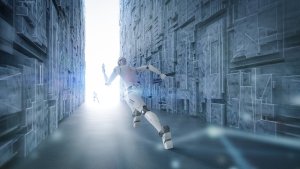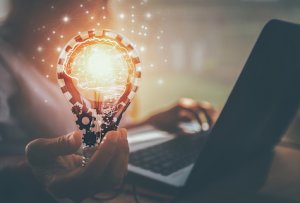How to guide innovative AI efforts to increase labor demand and create better-paying jobs?
Recent advances in artificial intelligence have triggered widespread anxiety about the future of work. These concerns aren’t misplaced. Unlike previous technological revolutions, which ultimately increased demand for labor, the current wave of AI development threatens to fundamentally alter the relationship between labor and capital in ways we have not seen before.
I strongly believe in the power of technological progress to improve human well-being. Innovation has been the primary driver of rising living standards throughout history. However, ensuring that these forces improve the human condition requires that technological advances move in the right direction and allow our institutions of governance to keep pace.
My recent research with Joseph Stiglitz examines how to guide technological progress—particularly in AI—to increase labor demand rather than diminish it. While technological advancement is often portrayed as an inevitable force beyond our control, our work challenges this technological fatalism. The future isn’t predetermined by blind technological forces or market dynamics that we are powerless to influence.
Instead, we argue that society can and should actively steer technological progress toward innovations that augment human capabilities rather than replace them. Moreover, in the longer term, if AI reaches human levels of intelligence, alternative ways of ensuring shared prosperity will be required, and technological progress should focus on improving human welfare more broadly.
The Alarming Trajectory of Labor-Saving Innovation
Looking at the evidence of recent decades, we should be concerned. While technological progress typically increases economic output, how these gains are distributed depends on the specific nature of the innovations involved. Progress can be labor-using (increasing wages) or labor-saving (reducing wages). Historically, even capital-biased innovations usually increased wages to some degree.
But recent data points to a troubling trend: many current innovations are distinctly labor-saving, threatening not just temporary job displacement but permanent wage depression. When economists like Acemoglu and Restrepo examine the impact of industrial robots on manufacturing communities, they find persistent negative effects on employment and wages that extend far beyond the directly affected sectors.
This trend is even more apparent when we look at wage growth over recent decades. While real GDP per capita has approximately doubled since 1980, median real wages for American workers have grown by barely 10%. For non-supervisory workers, real wages have stagnated. This divergence signals that technological progress is increasingly leaving workers behind.
If AI development continues along this path, we face the prospect of a future where machines can perform an ever-growing range of tasks more cheaply than humans. Market wages would be determined by how inexpensively machines could perform various jobs, resulting in steadily declining wages that could eventually fall below subsistence levels.
Not All AI Is Created Equal
The good news is that technological progress isn’t monolithic. Some innovations benefit workers while others harm them. Our research identifies key factors that determine whether an innovation will be labor-using versus labor-saving:
- Complementarity to labor: Does the innovation make human workers more productive, or does it replace them entirely?
- Factor share: How much of the economic value created by the innovation flows to labor versus capital?
- Market size and demand elasticity: How large is the market for the products affected, and how much does demand increase when prices fall?
- Relative income of affected workers: Are the workers affected by the innovation already well-off or relatively disadvantaged?
Consider these two contrasting AI applications:
Autonomous vehicles could potentially eliminate millions of driving jobs with few complementary benefits for the displaced workers.
Intelligent assistants, on the other hand, augment human capabilities by providing real-time guidance that makes workers more productive. For example, augmented reality devices could help less-skilled workers perform complex tasks by providing step-by-step instructions.
The difference between these two innovations is not just in their technical specifications—it is in their relationship to human labor. One aims to replace workers; the other aims to enhance their capabilities.
Actively Steering Technological Progress
Our technological trajectory is not inevitable. It is shaped by the choices we make—as individuals, as organizations, and as a society. Here are several approaches to steer technological progress in a more labor-friendly direction in the near term:
- Educate Entrepreneurs and Developers: Many technology entrepreneurs and AI researchers genuinely want their innovations to benefit society broadly. Providing better guidance on how specific design choices affect labor markets could help them make decisions that create more inclusive prosperity. The current focus on avoiding algorithmic bias could be expanded to include concerns about labor market impacts.
- Incentivize Labor-Using Innovation: Our tax system currently incentivizes replacing workers with machines. Labor is often the most heavily taxed factor in our economic system, creating strong motivation for labor-saving innovation. Simply adjusting these incentives—by reducing taxes on labor and potentially implementing targeted taxes on purely labor-replacing technologies—could significantly shift innovation toward labor-complementary technologies.
- Direct Government Research Funding: A substantial portion of AI research is conducted or funded by government agencies. These public investments should be evaluated not just on their technological merits but on their likely impact on labor markets. Research proposals could be required to include assessments of how the resulting innovations might affect different types of workers.
- Empower Workers in Technology Decisions: Workers’ councils and labor representatives who participate in corporate decision-making can help steer companies away from technologies designed to make workers more replaceable. Workers often have valuable insights into how technology could enhance rather than replace their contributions, but these perspectives are frequently overlooked in the innovation process.
- Non-Monetary Benefits of Work: Jobs provide more than just income—they offer identity, meaning, status, and social connections. When evaluating technological impact, we should consider these non-economic dimensions. As society becomes wealthier, the non-monetary aspects of work become increasingly important relative to pure income generation.
Concrete Examples of Labor-Friendly AI
What might labor-friendly AI look like in practice? Consider diagnostic AI systems that augment rather than replace healthcare professionals, providing recommendations that human doctors can evaluate and incorporate into their decision-making. Manufacturing assistants could guide less-skilled workers through complex assembly processes, effectively upskilling them rather than replacing them. AI-powered platforms might match workers with opportunities based on their unique skills and preferences, helping to create more efficient labor markets. Educational AI could personalize learning to help workers develop new capabilities throughout their careers, while communication tools could help teams collaborate across language barriers and time zones, expanding the range of projects that distributed teams can accomplish. These examples demonstrate how AI can enhance human capabilities and create value through complementarity rather than substitution.
Bridging to the Future
While the strategies above are critical for the near term, we should also be open to the possibility that they may not be sufficient forever. Our society has organized itself around labor as the primary mechanism for distributing income for centuries, but AI development may eventually challenge this fundamental arrangement. We may want to steer AI development toward labor-complementary technologies in the near term, recognizing the deep integration of work in our social structures and the challenge of rapidly transitioning to an alternative system. However, the long-term trajectory of technological progress suggests we should simultaneously begin to build institutional foundations for an economy in which humans can flourish even though labor may play a less central role. Such institutions should aim to create widespread prosperity even if the economic value of human labor diminishes.
These two strategies are not in conflict—they are complementary approaches operating on different time horizons. By actively steering technological progress in labor-friendly directions now, we buy time to carefully develop and implement the more fundamental changes that may be needed later.
The long-term trajectory of AI development may eventually lead to machines that can perform virtually all economically valuable tasks more cheaply than the subsistence cost of human labor. This potential future would require fundamental changes to how we organize our economy and society.
As the output produced by autonomous machines rises and the market value of labor declines, it would become optimal to gradually phase out work. The good news is that a world of abundant machine production means unprecedented levels of output that could, in principle, support everyone. The challenge is creating institutions to ensure this abundance is widely shared. A Seed Universal Income that automatically scales with the growth of non-labor income could provide one solution. Alternative approaches include public ownership stakes in AI companies or dividend systems that distribute the returns from technological progress. With the right institutions in place to share the gains of such technologies, the end of work could mean not destitution, but liberation—allowing humans to focus on creative pursuits, relationships, and activities that bring meaning and fulfillment independent of their market value.
Conclusion
The stakes are immense and require us to think both tactically and strategically. In the near term, there is a strong case for actively steering AI development toward technologies that complement human workers rather than replace them. This approach maintains the viability of labor markets while our social structures are still deeply tied to employment as the primary means of income distribution.
Simultaneously, we need to begin the difficult work of reimagining our economic institutions for a world where the traditional relationship between labor and capital may be fundamentally altered. By pursuing this dual approach—steering technology in the short term while building new systems for the long term—we can work toward a future where technological progress serves human flourishing in its broadest sense.
The path of technological development isn’t predetermined—it’s chosen. The choices we make today—both in the technological and the institutional realm—will shape not just our immediate economic landscape but the very foundations of our society for generations to come.





